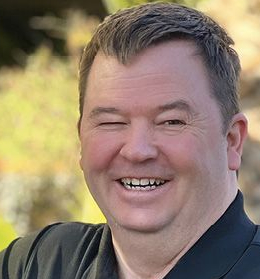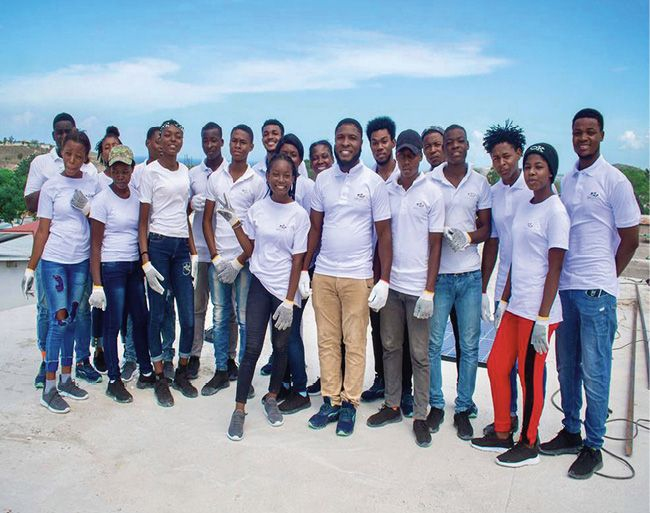Jonathan Gifford: Take me virtually to Haiti – what are some of the challenges people are facing?
Kevin Keene: Only 39% of the population have access to electricity. And those that do, they might live in areas like Port-au-Prince, where the grid only works for four hours a day. When they don’t have oil, sometimes it’s an hour a day or even an hour a week. Even the 39% that do have energy can’t rely on it. 
The situation impacts everyone. In Europe and the US we just can’t fathom it. If we lose power for a few hours we worry about wi-fi, refrigeration, and so on. But in Haiti there is just no energy. Everything that involves energy in Haiti is 100% human energy. There are mothers walking two miles to get five gallons of water for their family – and they are doing that a few times a day.
For cooking they are using charcoal, which is just devastating the countryside which is being stripped of trees, resulting in landslides and a decimated local habitat.
And in schools?
When you go into a schoolroom it’s dark, the students can’t see, and it’s hot, with no air conditioning or fans.
And other essential services?
 In medical clinics there is often no electricity – I just can’t imagine how they can provide treatment. For the hospitals that can rely on some generators for power, they can pay up to $15/gallon for diesel electricity – which equates to something like $3/kWh to $4/kWh. Whereas in the US we pay, on the high side, $0.30/kWh. Those hospitals could only work a few hours a day because of the cost of fuel, or only carry out surgery or other essential services. The bottom line is that Haitians don’t have money and whenever they do have money, the cost of energy is prohibitively expensive.
In medical clinics there is often no electricity – I just can’t imagine how they can provide treatment. For the hospitals that can rely on some generators for power, they can pay up to $15/gallon for diesel electricity – which equates to something like $3/kWh to $4/kWh. Whereas in the US we pay, on the high side, $0.30/kWh. Those hospitals could only work a few hours a day because of the cost of fuel, or only carry out surgery or other essential services. The bottom line is that Haitians don’t have money and whenever they do have money, the cost of energy is prohibitively expensive.
Given that background, how did you personally get involved?
In 2019, I had the opportunity to go to Haiti with a non-profit. We went to a rural school and installed a 24 kW solar system with batteries. When I looked around, within a two-hour radius there was no electricity at all. The schools are built to be dark but they are still oppressively hot. There’s little more than an old chalkboard and a four-foot bookshelf containing all the library books. And I thought that if there could be basic lighting, some tablets or computers, it would provide them with a world of information. So that is what sparked Brighten Haiti.
There have been a couple of iterations of the organization, but we thought that to really change poverty you have to start with education. It is the only and best weapon against poverty.
There are a lot of things we could do, but starting with solar means lighting, ceiling fans, and computer labs. The computer labs are amazing – fully self-contained because they don’t need the internet – they contain a world of information instead of one binder full of materials for the whole year. Now they can study virtually everything.
You mention the 24 kW system you helped to install. With Solar4Schools you’ve moved away from battery backup due to the islanding capability of the SMA inverters. Why was that?
The 24 kW system probably cost around $200,000 plus travel expenses and everything else. When I was back at home thinking how to scale this, I was thinking of 10 kW systems. The cost was $80,000 with batteries. That meant we could only do a few of those a year. So I took a closer look at my own SMA system at home and a lightbulb flashed in my mind. I literally jumped for joy. I called my friends at SMA, “I know these inverters are meant to be for backup power, but can they be used full time without the grid?” They said they could, I did some more testing and found that we can equip a school with a system for $6,000 which could provide 2 kW of energy, which vastly increases the number of schools that we can do: we are hoping to reach 109 schools over the next few years. The number 109 is the number of systems we have inverters for. We have the solar panels, we do need some racking and BOS [balance-of-system equipment] but we’re pretty much ready to go.
You mentioned in your award application that you are looking to use second-hand modules, or modules that would otherwise be discarded. What was the motivation for that?
Back in 2008, when I started in the solar industry, I knew that modules might have been designed and built to last 25 years, that they will still likely be producing energy at that point, and I would tell people that it is essentially free energy. They should be kept out of landfill and can provide energy to those who desperately need it.
Some of them are decommissioned modules from commercial projects. We got 800 modules that were 200 W each from Hawaii. We have some that are scratched and dent blemished – so not suitable for sale but still perfectly functional – from different solar installers. Some are virtually brand new but can’t be sold on the market. Some solar panel manufacturers give us their b-grade modules. So we keep solar panels out of landfill and, secondly, provide energy to those that need it.
The local training part of your program caught the eye of our Sustainability Award jurors – how did this come about?
A major component of what we are doing is training. If you’re going to go to a developing country to install solar and leave it, then the locals don’t know how to perform the O&M [operations and maintenance]. And also, part of the reason you’re doing this is to help lift people out of poverty. If you train local people how to install solar, then they can have a livelihood themselves. The tangible reward for me is seeing the 22 solar apprentices being provided with hope. Our instructor says that, unfortunately, some of our apprentices might have been in gangs right now if it weren’t for Brighten Haiti, because times are just so desperate. All of them have hope and they all come to class with great attitudes. The mission within the classroom is to really help the communities and it resonates with them because they can help their country become a better place.
And after the initial apprentices?
The plan is for those apprentices to do both residential microsystems and the Solar4Schools arrays. They will graduate and then bring in a second class. The idea is that we really want people from all corners of Haiti to be able to come to the apprenticeship training center and then return to their local communities and be able to perform ongoing maintenance and install locally as a livelihood.
How close are you to completing the 109 school installations?
We only have one system installed. Unfortunately, Port-au-Prince shut down, so it is a challenge to get access to our materials. We do have some material in Port-au-Prince, about 100 inverters in a warehouse there, but the area is controlled by gangs. Essentially, we’ve been delayed by six months. We check with our local contact every week and we just haven’t got hold of the material. As soon as we get access to the equipment, we can rapidly crank out the installations. The apprentices are ready, our map of schools is prepared, it is just a case of getting the materials.
To lay out just how difficult things are in Haiti now, our instructor tried to get basic parts from the local electrical distributor; he couldn’t even get a basic wall switch. So supply constraints of even the most basic things are a challenge.
Are things improving?
School was out for a year but started up in January 2023. That’s a good sign. We are getting reports that kidnappings are down but the gangs are moving towards being more like toll collectors, such as to drive on roads they control. We’re hoping that commerce will open back up and things can get a little better.
Do you want more PV industry support?
Yes, 100%. Our board is comprised entirely of industry veterans and the PV industry is our main support network. The more support we get then the more good we can do. A dollar in the US or a euro in Europe does some good but that same euro in Haiti can make a huge impact on thorough electrification, an impact for education, for medical clinics, and for the wider country.
This content is protected by copyright and may not be reused. If you want to cooperate with us and would like to reuse some of our content, please contact: editors@pv-magazine.com.

